FORMATION
TESTING
BACKGROUND
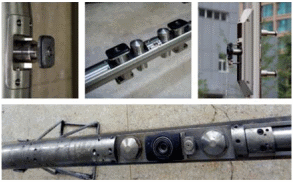
The formation tester is a (wireline or LWD) borehole logging tool which, when pressed against the sandface, extracts in situ fluids into collection chambers through pumping nozzles for chemical analysis at the surface. Pressure transients formed during pumping can be interrogated for reservoir properties like mobility or permeability. Formation testing provides direct measurements for key characteristics related to fluid movability, unlike resistivity, nuclear or acoustic logging, which are indirect - these properties are important to cash flow and production planning.
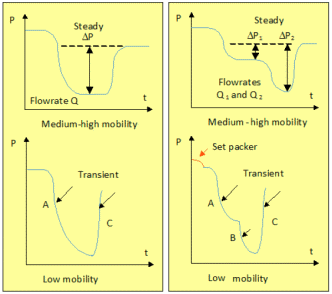
Early on, "single probe" tools measured steady-state responses and calculated effective, spherical permeability. Later, steady "dual probe" measurements in vertical wells offered both kh and kv (the author would extend this method for tools at arbitrary dip angle). However, both approaches decreased in popularity as target reservoirs became less mobile - equilibration to steady state often required hours (even days), thus increasing logging costs as well as risks for lost tools.
HALLIBURTONMark Proett and this author, then with Halliburton, developed a novel approach taking advantage of low permeability physics in the presence of (pressure distorting) flowline storage. Simple drawdown-buildup methods, well known in well testing, were extended to spherical flows. The resulting technique, forming the basis for the company's successful GeoTapTM service, required just seconds to predict spherical mobilities of 1 md/cp or below in single-probe tools.
UNITED STATES DEPARTMENT OF ENERGYIn 2004, the United States Department of Energy, through its Small Business Innovation Research (SBIR) program, awarded two hundred contracts for high risk research in diverse areas, e.g., nuclear, plasma physics, green energy, power distribution, and so on. Four were allocated to fossil fuels. Of these four, two targeted formation testing pressure transient analysis - both of these were awarded to Stratamagnetic Software, LLC.
The work developed in these researches, together with parallel activities conducted at CNOOC/COSL, China's premier oil service company, is reported in six books published from 2014 to and 2024 by John Wiley & Sons and Elsevier Science. Many novel "forward models" (calculating pressure for given formation and tool properties) and "inverse approahes" (predicting permeability or mobility when pressure responses and tool settings are specified) appear in these books. Importantly, new "rational polynomial" methods for effective spherical permeability are offered, which extend the capabilities of earlier approaches, as are new methods for newer generations of multiprobe tools with azimuthally distributed sensors. These permit faster and more accurate predictions.
In resistivity logging, coil transmitters broadcast constant frequency A/C signals that are monitored at receivers for phase delay and amplitude attenuation. These measurements are interpreted using Maxwell's equations to predict resistivity. We developed hardware and software analogies for formation testing. Our "transmitter" (pumping or source probe) would oscillate at fixed frequency, and time delays and pressure diffusion would be measured at observation "receiver" probe(s). Results would be interpreted by math models based on Darcy's equations. We combined this innovative method with single or double drawdown build-up analysis. The bottom line? Direct predictions for kh and kv, in very low permeability environments, in just seconds. A significant achievement indeed.
CHINA NATIONAL OFFSHORE OIL CORPORATION (CNOOC)Formation testing pressure transient (and contamination modeling) methods, as well as design and manufacturing technology, are shrouded in secrecy at leading oil service companies because they are high profit businesses. For relevant math model development, we needed both hardware and customer insights, which China's leading oil service company was willing to provide. In our years of mutual collaboration and trust, we were offered free and open access to all facilities and staff. The results are dozens of photographs and discussions published in our six jointly authored 2014-2024 books with John Wiley & Sons and Elsevier Science. Some sample photos appear below.
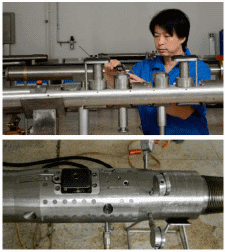
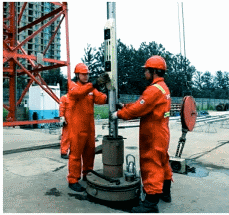
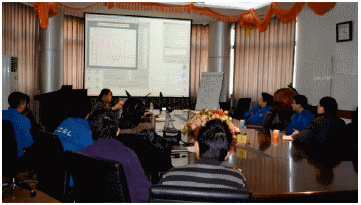
For additional information, particularly that related to MDT, COSL triple-probe and general multiprobe design, be sure to consult our six leading formation testing books co-authored with COSL colleagues available from John Wiley & Sons and Elsevier Science. Our models cover broad ranges of physics from single phase flow to contaminated multiphase behavior.
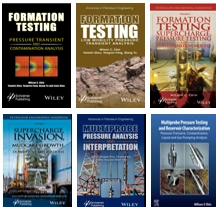
About Us
Home | Team Members | Papers | Patents | Books | Brochures | Contact |
Research, Science and Engineering
Home | Measurement While Drilling | Formation Testing | Fluid Rheology | Managed Pressure Drilling | Reservoir Engineering | Electromagnetic Modeling | Waves and Vibrations | Aerodynamics | Biomedical Imaging |
Copyright (C) 2025, by Stratamagnetic Software, LLC. All rights reserved.